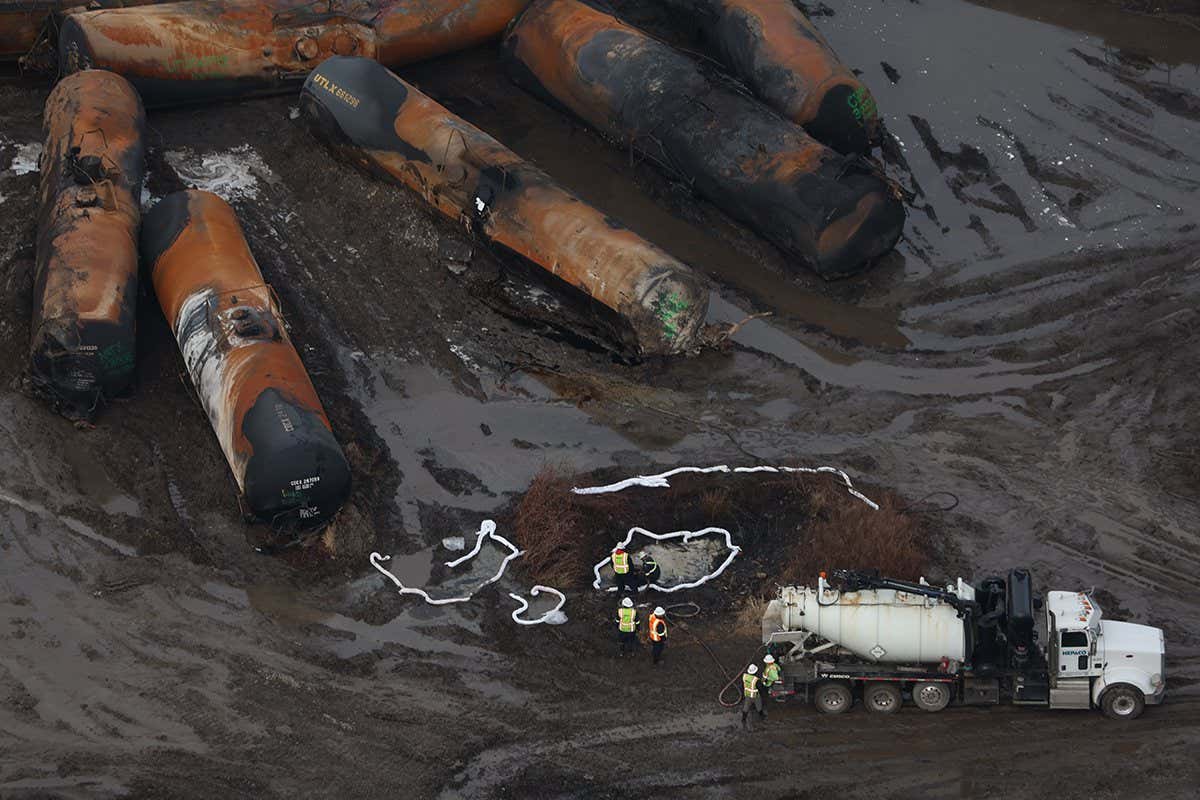Ohio Train Derailment: Long-Term Impact Of Toxic Chemical Exposure In Buildings

Table of Contents
Assessing the Extent of Building Contamination
The derailment released a cocktail of hazardous chemicals, raising critical questions about the extent of building contamination in East Palestine. Understanding the properties of these chemicals and their interaction with building materials is crucial in assessing the long-term risks.
Vinyl Chloride and its Impact on Building Materials
Vinyl chloride, a known carcinogen, is a volatile organic compound that can easily permeate building materials. Its gaseous nature allows it to seep into walls, insulation, flooring, and other porous materials. Prolonged exposure to vinyl chloride is linked to a range of severe health consequences.
- Building materials susceptible to vinyl chloride absorption: Drywall, insulation (fiberglass, foam), porous flooring (carpet, wood), and even paint.
- Potential health issues: Liver cancer, brain cancer, lung cancer, leukemia, and other serious health problems.
- Challenges in detecting and remediating vinyl chloride contamination: The volatile nature of vinyl chloride makes detection challenging. Remediation often requires specialized techniques and may involve complete material replacement in severely affected areas.
Butyl Acrylate and other Chemical Residues
Butyl acrylate, another chemical released in the derailment, is an irritant that can cause respiratory problems and skin irritation. Other released chemicals further complicate the situation, potentially leading to synergistic effects. The long-term effects of these combined exposures remain largely unknown.
- Specific health concerns: Respiratory issues (asthma, bronchitis, emphysema), skin irritation, allergic reactions, eye irritation, and potential neurological effects.
- Long-term effects on respiratory health: Chronic obstructive pulmonary disease (COPD) and other respiratory ailments are potential long-term consequences.
- Difficulties in identifying and removing all chemical traces: Many of these chemicals can bind to building materials, making complete removal extremely difficult.
The Role of Air and Water Contamination
Even after initial cleanup efforts, air and water contamination can significantly impact the indoor environment of buildings. Lingering chemical residues can persist in HVAC systems, plumbing, and other building components, leading to continued exposure.
- Strategies for air quality testing and remediation: Regular air quality testing using specialized equipment is crucial. Remediation may involve air filtration systems, ventilation improvements, and in severe cases, complete demolition and rebuilding.
- Water purification methods: Water testing and filtration systems are essential to ensure safe drinking water. This might involve whole-house filtration systems or connection to alternative water sources.
- The importance of regular monitoring: Continuous monitoring of both air and water quality is vital to ensure the safety of residents.
Long-Term Health Impacts on Building Occupants
The long-term health impacts of exposure to the chemicals released in the Ohio train derailment are a serious concern, particularly for vulnerable populations.
Respiratory Illnesses and Chronic Conditions
Exposure to these chemicals can lead to a range of respiratory illnesses, and long-term exposure increases the risk of developing chronic conditions.
- Link between chemical exposure and respiratory problems: Increased risk of asthma, bronchitis, COPD, and other respiratory issues.
- Potential for long-term health issues: Increased risk of cancer, cardiovascular disease, and neurological problems are all potential long-term effects.
- Specific symptoms to watch for: Persistent coughing, shortness of breath, wheezing, chest pain, and other respiratory symptoms. Seeking immediate medical attention is vital.
Impact on Children and Vulnerable Populations
Children, the elderly, and individuals with pre-existing health conditions are particularly vulnerable to the effects of toxic chemical exposure.
- Specific health risks for children: Developmental delays, respiratory problems, and increased susceptibility to infections.
- The importance of preventative measures: Regular health checkups, air filtration in homes, and limiting outdoor activities when air quality is poor are essential.
- Support services for vulnerable populations: Access to healthcare, mental health support, and financial assistance are crucial for vulnerable communities.
Environmental Cleanup and Building Remediation
The environmental cleanup and building remediation process following the Ohio train derailment present significant challenges.
Challenges in Complete Remediation
Completely removing toxic chemicals from buildings and the surrounding environment is an extremely difficult undertaking.
- Challenges of deep soil remediation: Contaminated soil can leach chemicals into groundwater and subsequently into building foundations.
- Difficulties in decontamination of porous building materials: Many building materials absorb chemicals, making complete decontamination nearly impossible.
- Need for advanced testing and technology: Advanced testing methods and specialized remediation technologies are necessary for effective cleanup.
Long-Term Monitoring and Surveillance
Ongoing monitoring and surveillance are essential to assess the long-term effects of the derailment and ensure the safety of the community.
- Techniques for long-term monitoring: Regular air and water quality testing, health screenings for residents, and environmental assessments.
- The role of government agencies and public health organizations: These agencies play a crucial role in coordinating cleanup efforts, providing health resources, and monitoring the long-term impacts.
- Importance of data transparency: Open access to data on air and water quality, health outcomes, and remediation progress is essential for public trust and informed decision-making.
Conclusion
The Ohio train derailment's long-term consequences on the health of East Palestine residents and the safety of their buildings remain a significant concern. Exposure to toxic chemicals like vinyl chloride and butyl acrylate poses serious health risks, underscoring the urgent need for comprehensive and sustained monitoring of air and water quality, coupled with rigorous building remediation efforts. Addressing the complexities of complete decontamination and ensuring long-term health surveillance for the affected populations is paramount. For the latest information and resources regarding the ongoing effects of the Ohio train derailment and its impact on building safety, consult reputable sources and engage with community support networks. If you have concerns about toxic chemical exposure in your building, contact your local health officials immediately.

Featured Posts
-
 Paddy Pimblett Calls Dustin Poiriers Retirement Idiot
May 05, 2025
Paddy Pimblett Calls Dustin Poiriers Retirement Idiot
May 05, 2025 -
 Emma Stones Quirky Snl Dress A Popcorn Butt Lift Moment
May 05, 2025
Emma Stones Quirky Snl Dress A Popcorn Butt Lift Moment
May 05, 2025 -
 Ufc 314 Fight Card Volkanovski Vs Lopes And The Full Lineup
May 05, 2025
Ufc 314 Fight Card Volkanovski Vs Lopes And The Full Lineup
May 05, 2025 -
 2025 Gold Market Double Digit Weekly Losses Raise Concerns
May 05, 2025
2025 Gold Market Double Digit Weekly Losses Raise Concerns
May 05, 2025 -
 Dope Girls Review Cocaine Electronica And Glamour In A Wwi Drama
May 05, 2025
Dope Girls Review Cocaine Electronica And Glamour In A Wwi Drama
May 05, 2025
Latest Posts
-
 The Fleetwood Mac Phenomenon Origin And Impact On The Supergroup Concept
May 05, 2025
The Fleetwood Mac Phenomenon Origin And Impact On The Supergroup Concept
May 05, 2025 -
 Fleetwood Macs Legacy A Pioneer Of The Supergroup Genre
May 05, 2025
Fleetwood Macs Legacy A Pioneer Of The Supergroup Genre
May 05, 2025 -
 Izdanje Inspirirano Gibonni Na Sarajevskom Sajmu Knjiga
May 05, 2025
Izdanje Inspirirano Gibonni Na Sarajevskom Sajmu Knjiga
May 05, 2025 -
 The Story Behind Rumours Fleetwood Macs 48 Year Old Legacy Of Broken Relationships And Musical Genius
May 05, 2025
The Story Behind Rumours Fleetwood Macs 48 Year Old Legacy Of Broken Relationships And Musical Genius
May 05, 2025 -
 Gibonnijeva Posjeta Sarajevskom Sajmu Knjiga Sto Ocekivati
May 05, 2025
Gibonnijeva Posjeta Sarajevskom Sajmu Knjiga Sto Ocekivati
May 05, 2025
